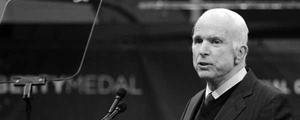GALLUP NEWS SERVICE
PRINCETON, NJ -- Recent USA Today/Gallup presidential heats measures indicate the 2008 election is not going to be easy for either party. Various pairings of the leading Republican and Democratic contenders generally result in extremely close races. If such early indications are correct, to win, the candidates may need to maximize their support from all sides: their political base, political independents, and even members of the opposing party.
Data from the Feb. 9-11, 2007 survey suggest the leading candidates have very different chances of accomplishing such a political trifecta. Only one candidate, former New York mayor Rudy Giuliani, has relatively strong favorable ratings across the political spectrum. New York Sen. Hillary Rodham Clinton is highly rated by Democrats, but receives relatively weak reviews from independents and Republicans. Arizona Sen. John McCain and Illinois Sen. Barack Obama fall somewhere in between.
Below is a summary of the net favorable ratings (percentage favorable minus percentage unfavorable) for each candidate. A full discussion of these ratings follows.
|
Net Favorable Ratings for Potential 2008 Candidates
|
||||
|
Net
|
Net
|
Net
|
Net
|
|
|
Giuliani |
70 |
47 |
18 |
44 |
|
Obama |
48 |
39 |
10 |
34 |
|
McCain |
48 |
30 |
17 |
31 |
|
Clinton |
77 |
10 |
-42 |
18 |
|
Edwards |
45 |
21 |
-20 |
18 |
|
Gore |
49 |
10 |
-47 |
7 |
Clinton and Giuliani Are Favorites With Home Teams
Of the leading Republican and Democratic contenders for their party's nominations (those garnering double-digit support), Hillary Clinton is the most popular with members of her own political party: 87% of Democrats view her favorably while only 10% view her unfavorably, resulting in a net +77 image score.
Rudy Giuliani receives nearly as much same-party adulation with a +70 positive image score from fellow Republicans.
Al Gore, Barack Obama, and John McCain all cluster well behind these party favorites with positive image scores from their own parties of just 48 or 49 points. Former North Carolina Sen. John Edwards is even further behind with a +35 score.
|
Favorable Ratings of Potential Candidates
|
||||
|
Favorable |
Unfavorable |
No
|
Net
|
|
|
% |
% |
% |
|
|
|
Clinton
|
87 |
10 |
3 |
77 |
|
Giuliani
|
80 |
10 |
10 |
70 |
|
Gore
|
72 |
23 |
5 |
49 |
|
Obama
|
62 |
14 |
24 |
48 |
|
McCain
|
69 |
21 |
10 |
48 |
|
Edwards
|
61 |
16 |
22 |
45 |
Independents Favorable to Giuliani
Democratic adulation is about where Clinton's image strength ends. While she is viewed more favorably than unfavorably among independents (55% favorable vs. 45% unfavorable) her +10 image score with this group lags well behind the most popular candidates. (Gore's ratings among independents are nearly identical to Clinton's.)
Giuliani sets the bar for independents' views of the 2008 presidential candidates. Two-thirds of independents view him favorably and only 21% unfavorably, yielding a +47 image score.
Obama follows next with +39. McCain and Edwards also fare well with solidly positive image scores of +30 and +21, respectively. In contrast to Clinton and Gore, none of these candidates are viewed unfavorably by more than 3 in 10 independents.
|
Favorable Ratings of Potential 2008 Candidates
|
||||
|
Favorable |
Unfavorable |
No
|
Net
|
|
|
% |
% |
% |
|
|
|
Giuliani |
68 |
21 |
11 |
47 |
|
Obama |
55 |
16 |
29 |
39 |
|
McCain |
56 |
26 |
18 |
30 |
|
Edwards |
50 |
29 |
21 |
21 |
|
Clinton |
55 |
45 |
0 |
10 |
|
Gore |
54 |
44 |
2 |
10 |
Republican Frontrunners Have Most Crossover Appeal
Clinton's image descends much deeper with Republicans; 28% view her favorably and 70% view her unfavorably, yielding a -42 image score. The only other candidate to receive comparably negative ratings from the opposing party is Gore, with a -47 score among Republicans.
By contrast, both Republican frontrunners -- Giuliani and McCain -- are viewed more positively than negatively by Democrats, albeit by fairly narrow margins of +18 and +17, respectively.
Also proving that partisans don't automatically frown on politicians from the opposing party, Obama is viewed more positively than negatively (+10) by Republicans.
|
Favorable Rating of Potential 2008 Candidates
|
||||
|
Favorable |
Unfavorable |
No
|
Net
|
|
|
% |
% |
% |
|
|
|
Giuliani
|
50 |
32 |
18 |
18 |
|
McCain
|
48 |
31 |
21 |
17 |
|
Obama
|
39 |
29 |
32 |
10 |
|
Edwards
|
32 |
52 |
16 |
-20 |
|
Clinton
|
28 |
70 |
2 |
-42 |
|
Gore
|
25 |
72 |
3 |
-47 |
Giuliani on Top
The net effect of the candidates' favorable scores according to party affiliation is seen in their overall ratings with the general public.
|
Favorable Ratings of Potential 2008 Candidates
|
||||
|
Favorable |
Unfavorable |
No
|
Net
|
|
|
% |
% |
% |
||
|
Giuliani |
66 |
22 |
12 |
44 |
|
Obama |
53 |
19 |
28 |
34 |
|
McCain |
57 |
26 |
17 |
31 |
|
Clinton |
58 |
40 |
2 |
18 |
|
Edwards |
49 |
31 |
20 |
18 |
|
Gore |
52 |
45 |
3 |
7 |
With relatively high ratings from Republicans, independents, and Democrats, Giuliani enjoys the most positive national image of the six presidential frontrunners (+44 net favorable). He is followed fairly closely by McCain and Obama. These three also have a sizable number of Americans expressing no opinion of them (at least 12%), which provides some valuable opportunity to improve their ratings as more people get to know them.
Gore has the lowest national image score (+7). Not only does he receive mixed reviews from independents and poor reviews from Republicans, his image among Democrats is far from optimal. Clinton's national image score (+18) is only slightly better, specifically because she is nearly universally applauded by Democrats.
Both Clinton and Gore have minimal "no opinion" scores. Thus, to improve their favorable scores, they must convert some of their critics into fans.
Edwards has the same low net favorable score as Clinton (+18), but is still unknown to 20% of Americans. That may put Edwards in a slightly better position than Clinton in that it is, in theory, easier to move someone from "no opinion" to a favorable view than to convert an unfavorable opinion into a favorable one.
Obama Gains
For the most part, the candidates' public images have remained fairly stable over the past few months. The favorable ratings of most have fluctuated only slightly up or down since November of 2006.
The main exception to this is Obama, whose favorable -- as well as unfavorable -- ratings have increased as the public has grown more familiar with him. Last December, nearly half the general public had no opinion of him. As that declined to 28%, the percentage viewing him favorably has risen from 42% to 53%. His unfavorable rating also rose from 11% to 19%.
Thus, his overall net favorable image has not changed much, rising from +31 in December to the +34 where it stands today.
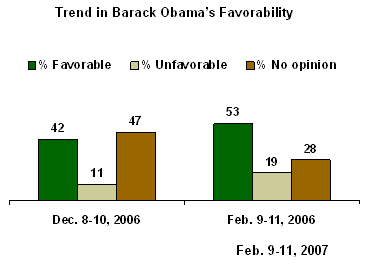
Clinton Rebounds
Views of Hillary Clinton have become slightly more positive since last fall: 58% favorable today, up from 53% in November 2006. However, her current rating is notable because it is the highest favorable score she has received from the American public since the end of her tenure as first lady. It is also substantially improved over her post-White House low point of 44% favorable and 53% unfavorable, recorded in March 2001.
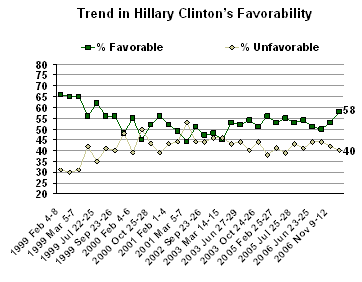
Giuliani and McCain Fairly Steady
Favorable ratings of Giuliani are generally consistent with where they have been since last summer, except for a one-time 77% rating in December 2006. His unfavorable rating has inched up fairly slowly, from 14% in August 2004 to 22% today.
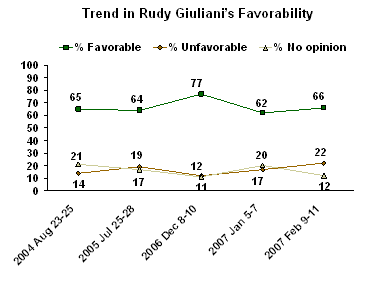
McCain's run for the presidency in 2000 marked his entry onto the national stage and favorable ratings of him that year averaged 61%. Since then, his rating has bounced around some, but has averaged 55%, similar to the 57% recorded in the latest poll.
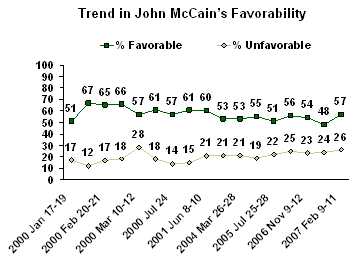
Survey Methods
Results are based on telephone interviews with 1,006 national adults, aged 18 and older, conducted Feb. 9-11, 2007. For results based on the total sample of national adults, one can say with 95% confidence that the maximum margin of sampling error is ±3 percentage points. In addition to sampling error, question wording and practical difficulties in conducting surveys can introduce error or bias into the findings of public opinion polls.
